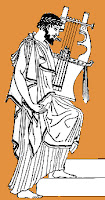Let the games begin! At last the athletics contests start and we get a chance to see what effect all that hard training has had on all those naked male sportsmen.
Like in the modern Olympics there were several different events, enough for 2 days competition, so I’ll divide them up into 2 parts. Today I’ll look at the track and field events.
These were introduced by Peisitratus (already mentioned several times this week) in 566 BC and were purely for entertainment and not part of the religious festival it accompanied.
Most of the track races were much like the Olympics races but different in a couple of ways. Originally they were held in the agora, the central meeting and market place. A special wooden stadium was later built, which in 330 BC it was rebuilt in marble. This is the stadium that hosted the first modern Olympics in 1896. The second difference was that the races were arranged into 3 age groups – 12-15 years, 16-20 years, and the over 20s. In this respect it’s more like the modern Gay Games, where medals are awarded according to age groups.
The races were held in heats and finals, with the youngest age groups having all their races first. This would have given their older mentor/boyfriends chance to watch and cheer them on, and later the younger athletes could do the same for their older partners. The over-20s had an extra race – a race in armour. Not full armour, but with helmet, shield and shin guards. Apart from that they were competed naked.
Non-Athenians were allowed to compete, but perhaps in their own separate races, and no-one at this stage represented anyone other than themselves, there was no national grouping. As in the ancient Olympics, their victories could not be claimed by their home city or country.

Instead of medals, vases of olive oil (like the one pictured left) were awarded to the top 2 winners of the finals, 10 for the second place, and between 40 and 50 (depending on the event) for the first. I hope the London Olympics don’t decide to save money and follow this example by handing out bottles of Tesco’s Value olive oil! But the Athenian oil was special. It was made from olives grown in the scared groves of Academia outside the city walls. The Athenians believed that if they kept the sacred oil and rubbed it on their bodies at future games they could increase their strength, speed and agility, a bit like Popeye’s spinach, though I don’t recommend rubbing spinach on your body! The oil could be sold for a very high price, being sacred oil, and the few surviving vases are highly valuable today.
Vases of oil were also awarded to the winners of the pentathlon. This was also much like the modern event. It consisted of a track race, javelin, discus, long jump and Greek-style wrestling. No-one is sure if the pentathlon contest was won on points like it is today.
So they were the track and field events. Also held on Days 3 and 4 were the wrestling and boxing matches. I’ll tell you all about those tomorrow.

























